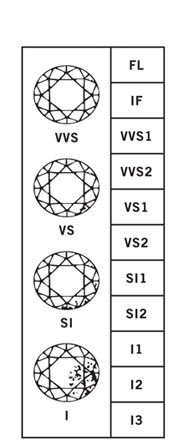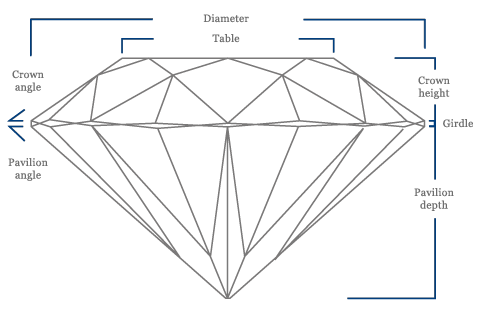
*Images not to scale
0.50ct. = 5.20mm
0.75ct. = 6.00mm
1.00ct. = 6.50mm
2.00ct. = 8.20mm
5.00ct. = 11.00mm
Diamond Grading
Carat
Diamond weight is measured using the metric carat system whereby 1 metric carat (1 ct.) = 0.2 gram
Each carat is divided into 100 points. For example, a 30-point diamond weighs 0.30 carats.
Don’t confuse karat with carat – CARAT refers to stone weight whereas KARAT refers to purity of gold.
Diamonds are often weighed to the hundred thousandths of a carat, and rounded to a hundredth of a carat. Specialized scales under controlled conditions are used to ensure accurate weight measurement.

Clarity
The FL Grade (Flawless)
The term FL or flawless is used for diamonds in which a qualified observer, under favourable lighting conditions, cannot find internal characteristics and/or faults by thorough examination with a 10X corrected loupe.
The IF Grade (Internally Flawless)
A diamond which has no internal characteristics but which, due to minor finish faults, is not flawless and therefore cannot be designated FL or flawless, may be called IF or internally flawless provided the finish faults are so minute that they can be removed by a gentle polishing with only an insignificant loss of weight.
The VVS Grades (Very, Very Small Inclusions)
The term VVS is used for diamonds with internal characteristics very, very difficult for a qualified observer to find under observation consitions as described. Further, there may only occur insignificant finish faults.
The VS Grades (Very Small Inclusions)
The term VS is used for diamonds in which it is difficult for a qualified observer, under observation conditions as described, to find either a few somewhat larger internal characteristics or several very small ones.
The SI Grades (Small Inclusions)
The term SI is used for diamonds in which a qualified observer may, without difficulty, under observation conditions as described, find internal characteristics. Further, there may ony occur single finish faults of an insignificant kind.
The I Grades (Imperfect)
The term I or imperfect is used for diamonds in which a qualified observer, with the naked eye, can see internal characteristics and/or in which such major faults occur, which substantially reduce the value of the stone.
Diamonds often possess unique markings – either internal (known as inclusions) or external (known as blemishes).
A diamond’s clarity grade depends on the absence or abundance of such inclusions and blemishes.
The GIA International Diamond Grading System™ assigns a clarity grade to a diamond ranging from Flawless (FL) to diamonds with highly visible inclusions (I-3).
The clarity grade is determined by a gemologist using 10x magnification and a trained eye.
The following lists some commonly used terminology to describe a diamond’s internal and external characteristics:
External
- Natural – unpolished surface, the original ‘skin’ of rough diamond
- Pit – small indentation on a flat surface
- Cavity – opening on surface
- Nick – minor surface chip
- Grain/twinning line – irregularity in crystal growth
- Scratch – small groove (can be due to normal wear)
- Chip – broken along external edge
Internal
- Cleavage or feather – inclusion along atomic grain
- Fracture – irregular shaped break
- Included – inclusions within diamond
- Carbon spot – included crystal (dark)
- Pinpoint – small included crystal (appears white)
- Cloud – group of pinpoints
- Internal grain line – visible part of internal grain structure
- Laser drill hole – clarity enhancement to remove/reduce appearance of inclusions
- Bearded or feathered girdle – minute to small hairline fracture extending from girdle into stone
The clarity grade of a diamond not only affects the value and price, but can also be a good indication of the diamond’s vulnerability. Heavily included diamonds can be prone to breakage.

| Colourless | D E F |
| Near Colourless | G H I J |
| Slightly Tinted | K L M N |
| Very Light Yellow | O P Q |
| Light Yellow | R S T |
| Yellow | U to Z |
| Fancy Colour | |
Color
The industry standard for diamond color was developed by the Gemological Institute of America (GIA) – the educational institution that sets the international standard for diamond grading. GIA Color Scale begins with the letter D, representing colorless, and continues with increasing color to the letter Z. Each letter grade has a clearly defined range of color appearance. Diamonds are color graded by comparing each stone to master stones of each known color under controlled lighting conditions. Master stone sets utilized by GS Laboratories are carefully and rigorously chosen and tested by the GIA before being accepted.
Generally, the less color a diamond possesses, the more valuable it becomes. The exception to this is fancy colored diamonds, which lie outside the color scale range. If a diamond is colored, it will command value only if it reaches the point of color saturation where it becomes rare or if the color itself is rare.
| Ideal |
| Excellent |
| Very good |
| Good |
| Medium |
| Fair |
| Poor |
Cut
The shape of a diamond and the make (proportion and finish) are both elements of the diamond’s cut. The better a diamond has been cut (i.e. the better the make), the more brilliant a diamond will appear.
If a diamond is pleasing to the eye, it probably has very good angles, facet junctions and polish. To better understand make and cut, look at the following images:

Light travels best through the diamond in the first image – it has the best dimensions, angles and finish, so light exits through the top of the diamond as sparkle. In the other images, the diamonds lose that sparkle through their undersides due to poorer cut.
The cut grade of a diamond refers to its proportions, symmetry and polish (finish). Consider the main aspects of a round brilliant cut diamond: the table, crown, girdle, pavilion and culet:

The proportions of a diamond refer to the relationships between the table size, crown angle and pavilion depth. Based on these proportions and relationships, a diamond’s cut grade will fall within one of these categories:
- Ideal
- Excellent
- Very good
- Good
- Medium
- Fair
- Poor
In addition to the angles and proportions, the finish, which includes the overall polish of the diamond, the condition of the girdle (thickness and texture) and culet (not being nicked, chipped, abraded, out of alignment or off center) and the symmetry of the facets (meeting at the apexes and correctly positioned) are essential to the beauty and appearance of the well cut and proportioned diamond.
